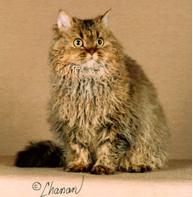
The basis for the Selkirk Rex breed is a mutation that causes a curly coat. The foundation cat for this breed was a shorthaired, curly coated dilute calico female found in a litter of normal domestic cats born in 1987. The straight coated mother and her family of five straight coated kittens and one curly kitten landed in an animal shelter. The unusual kitten was given to Jeri Newman, an experienced Persian breeder, and named Miss DePesto. When she reached maturity she was bred to Jeri's champion black Persian, Photo Finish of DeeKay.
The resulting litter of six contained three curly coated kittens. This proved that the gene was dominant, unlike the recessive gene of the Devon or Cornish Rex. Because there was only one kitten with the curly coat in Miss De Pesto's litter, it is presumed that this was a spontaneous mutation that Miss DePesto then passed on to her offspring.
Jeri decided to name the breed after her stepfather, although she told people it was named after the Selkirk Mountains in Wyoming, (which are actually in Canada!) near to where the original cat was found.
The coat is thick and plush and falls in loose curls. The coat is soft in texture, unlike the stiffness of an American Wirehair.
Selkirks come in a rainbow of colors, including the "pointed" colors, as the original cat was carrying the pointed gene. Because Exotic Shorthairs (some of whom have Burmese cats in their background) are an allowed outcross, burmese and "mink" colored cats have also been produced.
Kittens appear very curly at birth, but then they go through an awkward "straight" stage. Upon full maturity, the coat comes into its full glory. This is a very slow developing breed, but with time, the full head development (with jowls) and body maturity, as well as the coat quality, will improve.
No breed of cat is hypoallergenic. Different people are allergic to different cat proteins. People who are allergic to cat saliva can find that rinsing ANY shorthaired cat in plain water once a week to one a month will keep allergy problems to a minimum.
Devon and Cornish Rex have a reduced number of hairs in their coat. This provides less surface area to trap allergenic proteins from the saliva or the skin. The Selkirk Rex, on the other hand, does NOT have a reduced number of hairs. A shorthaired Selkirk will shed as much as an Exotic Shorthair and a longhaired Selkirk can shed as much as a Persian.
The temperament of the Selkirk reflects that of the breeds used in its development. They have a lot of the laid-back, reserved qualities of the British Shorthair, the cuddly nature of the Persian, and the playfulness of the Exotic Shorthair. They are very patient, tolerant, and loving.
Definitely not! Although every type of hair is present and modified in the Selkirk coat: guard, awn, and down - just like the American Wirehair - the quality of this coat is much different. Also, when an American Wirehair is born, a breeder will have to wait weeks to be able to determine whether the kitten is wired or not. Not so with the Selkirk! The minute a little curly Selkirk kitten enters this world, he is the curliest he will be for the first year and a half of his life.
The standard for the American Wirehair describes an American Shorthair in every aspect except coat. The Selkirk Rex is being selectively bred to a completely different look, much closer to that of the British Shorthair, but distinct from that cat as well, especially in the length of the legs.
Yes, the cats who are homozygous for the curly coat factor have a sparser, 'tighter" coat than those who only have one Selkirk parent. Right now, it appears that the heterozygous cats most closely fit our standard, but the homozygous cats are very valuable to our breeding programs, as every kitten produced by that cat will be curly.
The Selkirk Rex genetic factor does not appear to be debilitating in homozygous form. However, some transient problems have been seen in a few homozygous cats, most probably due to breeding too closely on the original cats, rather than because of the nature of the genetic mutation.
At this time, outcrossing is our primary focus, to help build the foundation gene pool on which our breed will depend in the future.
Right now the availability of Selkirks is quite limited. But we hope that this breed will continue to grow to help fill the demand for kittens. The price of pet, breeding, and show quality Selkirks is similar to most other purebred cats.
Breeders of all breeds of cats may be found through the Fanciers breeder listing page. Also visit the Selkirk Rex Yahoogroup for a list of breeders.
Right now, preference for the placement of breeding stock is being given to established breeders of one of the outcross breeds for the Selkirk Rex: British Shorthairs, Exotics, and Persians (all divisions, including Himalayans). We are especially looking for people with experience in showing. In order to fulfill our requirements for acceptance by CFA (this breed is already accepted for championship competition in TICA), we particularly need breeders who are willing to register and show their cats in this association.
Selkirks are still only just a few generations away from their domestic roots, so the breed is very hardy. We are attempting to bring in as many different lines of outcrosses as possible, in order to give ourselves a large gene pool from which to build this breed.
This FAQ has been brought to you by the Selkirk Rex Breed Club, a CFA affiliated club for the promotion and betterment of the Selkirk Rex breed. It was written by Lorraine Shelton, founding Vice-President.
Membership in this club, including a subscription to the quarterly newsletter, Woolgathering, can be obtained by sending $15 to:
Donna
Bass
P.O. Box 461
Oakland, CA 94604-0461.